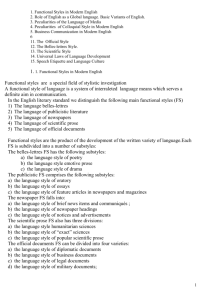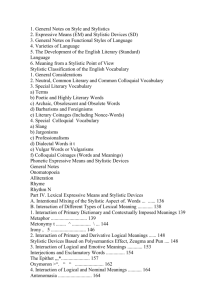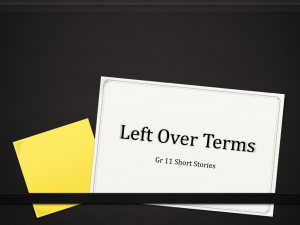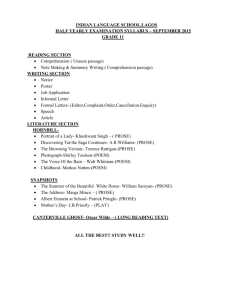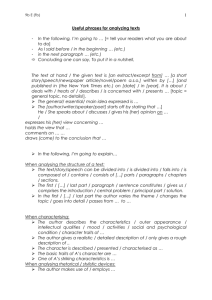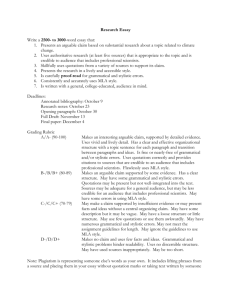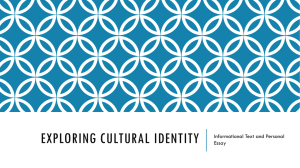styles prose
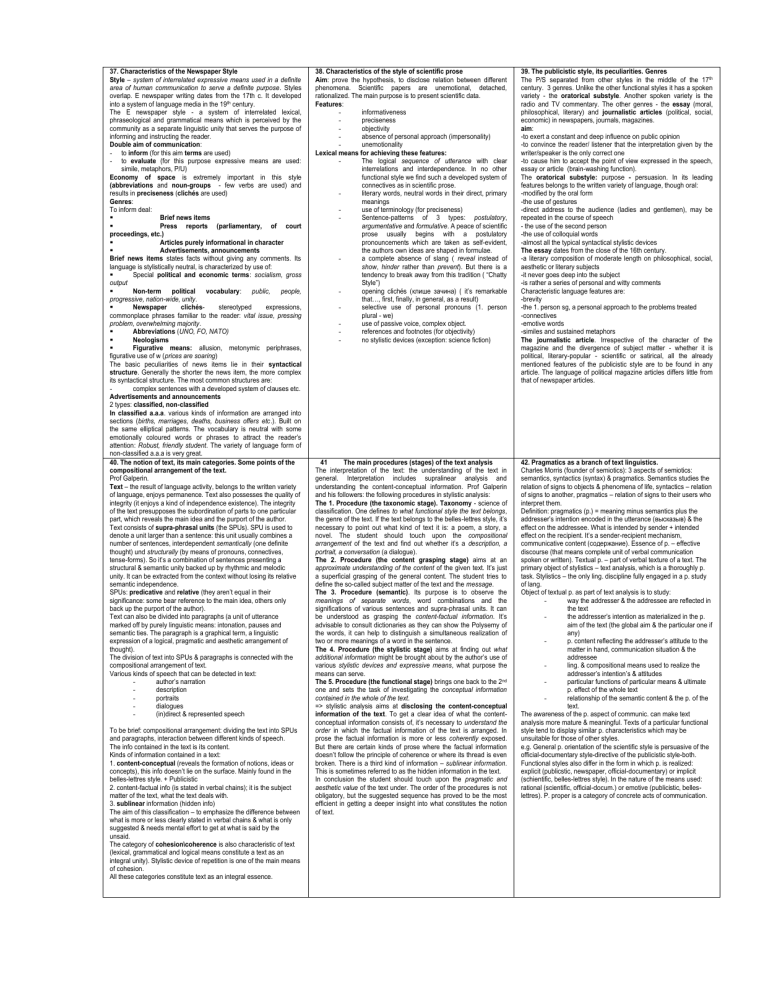
37. Characteristics of the Newspaper Style
Style – system of interrelated expressive means used in a definite
area of human communication to serve a definite purpose. Styles overlap. E newspaper writing dates from the 17th c. It developed into a system of language media in the 19 th century.
The E newspaper style - a system of interrelated lexical, phraseological and grammatical means which is perceived by the community as a separate linguistic unity that serves the purpose of informing and instructing the reader.
Double aim of communication:
to inform (for this aim terms are used)
to evaluate (for this purpose expressive means are used: simile, metaphors, P/U)
Economy of space is extremely important in this style
(abbreviations and noun-groups - few verbs are used) and results in preciseness (clichés are used)
Genres:
To inform deal:
Brief news items
Press reports (parliamentary, of court proceedings, etc.)
Articles purely informational in character
Advertisements, announcements
Brief news items states facts without giving any comments. Its language is stylistically neutral, is characterized by use of:
Special political and economic terms: socialism, gross
output
Non-term political vocabulary: public, people,
progressive, nation-wide, unity.
Newspaper clichés- stereotyped expressions, commonplace phrases familiar to the reader: vital issue, pressing
problem, overwhelming majority.
Abbreviations (UNO, FO, NATO)
Neologisms
Figurative means: allusion, metonymic periphrases, figurative use of w (prices are soaring)
The basic peculiarities of news items lie in their syntactical
structure. Generally the shorter the news item, the more complex its syntactical structure. The most common structures are: complex sentences with a developed system of clauses etc.
-
Advertisements and announcements
2 types: classified, non-classified
In classified a.a.a. various kinds of information are arranged into sections (births, marriages, deaths, business offers etc.). Built on the same elliptical patterns. The vocabulary is neutral with some emotionally coloured words or phrases to attract the reader’s attention: Robust, friendly student. The variety of language form of non-classified a.a.a is very great.
40. The notion of text, its main categories. Some points of the compositional arrangement of the text.
Prof Galperin.
Text – the result of language activity, belongs to the written variety of language, enjoys permanence. Text also possesses the quality of integrity (it enjoys a kind of independence existence). The integrity of the text presupposes the subordination of parts to one particular part, which reveals the main idea and the purport of the author.
Text consists of supra-phrasal units (the SPUs). SPU is used to denote a unit larger than a sentence: this unit usually combines a number of sentences, interdependent semantically (one definite thought) und structurally (by means of pronouns, connectives, tense-forms). So it’s a combination of sentences presenting a structural & semantic unity backed up by rhythmic and melodic unity. It can be extracted from the context without losing its relative semantic independence.
SPUs: predicative and relative (they aren’t equal in their significance: some bear reference to the main idea, others only back up the purport of the author).
Text can also be divided into paragraphs (a unit of utterance marked off by purely linguistic means: intonation, pauses and semantic ties. The paragraph is a graphical term, a linguistic expression of a logical, pragmatic and aesthetic arrangement of thought).
The division of text into SPUs & paragraphs is connected with the compositional arrangement of text.
Various kinds of speech that can be detected in text:
author’s narration
description
-
portraits dialogues
(in)direct & represented speech
-
To be brief: compositional arrangement: dividing the text into SPUs and paragraphs, interaction between different kinds of speech.
The info contained in the text is its content.
Kinds of information contained in a text:
1. content-conceptual (reveals the formation of notions, ideas or concepts), this info doesn’t lie on the surface. Mainly found in the belles-lettres style. + Publicistic
2. content-factual info (is stated in verbal chains); it is the subject matter of the text, what the text deals with.
3. sublinear information (hidden info)
The aim of this classification – to emphasize the difference between what is more or less clearly stated in verbal chains & what is only suggested & needs mental effort to get at what is said by the unsaid.
The category of cohesion\coherence is also characteristic of text
(lexical, grammatical and logical means constitute a text as an integral unity). Stylistic device of repetition is one of the main means of cohesion.
All these categories constitute text as an integral essence.
38. Characteristics of the style of scientific prose
Aim: prove the hypothesis, to disclose relation between different phenomena. Scientific papers are unemotional, detached, rationalized. The main purpose is to present scientific data.
Features:
informativeness
-
preciseness objectivity absence of personal approach (impersonality)
-
unemotionality
Lexical means for achieving these features:
-
The logical sequence of utterance with clear interrelations and interdependence. In no other functional style we find such a developed system of connectives as in scientific prose.
-
-
-
-
-
-
-
-
literary words, neutral words in their direct, primary meanings use of terminology (for preciseness)
Sentence-patterns of 3 types: postulatory,
argumentative and formulative. A peace of scientific prose usually begins with a postulatory pronouncements which are taken as self-evident, the authors own ideas are shaped in formulae. a complete absence of slang ( reveal instead of
show, hinder rather than prevent). But there is a tendency to break away from this tradition ( “Chatty
Style”) opening clichés (клише зачина) ( it’s remarkable that…, first, finally, in general, as a result) selective use of personal pronouns (1. person plural - we) use of passive voice, complex object. references and footnotes (for objectivity) no stylistic devices (exception: science fiction)
39. The publicistic style, its peculiarities. Genres
The P/S separated from other styles in the middle of the 17 th century. 3 genres. Unlike the other functional styles it has a spoken variety - the oratorical substyle. Another spoken variety is the radio and TV commentary. The other genres - the essay (moral, philosophical, literary) and journalistic articles (political, social, economic) in newspapers, journals, magazines.
aim:
-to exert a constant and deep influence on public opinion
-to convince the reader/ listener that the interpretation given by the writer/speaker is the only correct one
-to cause him to accept the point of view expressed in the speech, essay or article (brain-washing function).
The oratorical substyle: purpose - persuasion. In its leading features belongs to the written variety of language, though oral:
-modified by the oral form
-the use of gestures
-direct address to the audience (ladies and gentlemen), may be repeated in the course of speech
- the use of the second person
-the use of colloquial words
-almost all the typical syntactical stylistic devices
The essay dates from the close of the 16th century.
-a literary composition of moderate length on philosophical, social, aesthetic or literary subjects
-it never goes deep into the subject
-is rather a series of personal and witty comments
Characteristic language features are:
-brevity
-the 1. person sg, a personal approach to the problems treated
-connectives
-emotive words
-similes and sustained metaphors
The journalistic article. Irrespective of the character of the magazine and the divergence of subject matter - whether it is political, literary-popular - scientific or satirical, all the already mentioned features of the publicistic style are to be found in any article. The language of political magazine articles differs little from that of newspaper articles.
41 The main procedures (stages) of the text analysis
The interpretation of the text: the understanding of the text in general. Interpretation includes supralinear analysis and understanding the content-conceptual information. Prof Galperin and his followers: the following procedures in stylistic analysis:
The 1. Procedure (the taxonomic stage). Taxonomy - science of classification. One defines to what functional style the text belongs, the genre of the text. If the text belongs to the belles-lettres style, it’s necessary to point out what kind of text it is: a poem, a story, a novel. The student should touch upon the compositional
arrangement of the text and find out whether it’s a description, a
portrait, a conversation (a dialogue).
The 2. Procedure (the content grasping stage) aims at an
approximate understanding of the content of the given text. It’s just a superficial grasping of the general content. The student tries to define the so-called subject matter of the text and the message.
The 3. Procedure (semantic). Its purpose is to observe the
meanings of separate words, word combinations and the significations of various sentences and supra-phrasal units. It can be understood as grasping the content-factual information. It’s advisable to consult dictionaries as they can show the Polysemy of the words, it can help to distinguish a simultaneous realization of two or more meanings of a word in the sentence.
The 4. Procedure (the stylistic stage) aims at finding out what
additional information might be brought about by the author’s use of various stylistic devices and expressive means, what purpose the means can serve.
The 5. Procedure (the functional stage) brings one back to the 2 nd one and sets the task of investigating the conceptual information
contained in the whole of the text.
=> stylistic analysis aims at disclosing the content-conceptual
information of the text. To get a clear idea of what the contentconceptual information consists of, it’s necessary to understand the
order in which the factual information of the text is arranged. In prose the factual information is more or less coherently exposed.
But there are certain kinds of prose where the factual information doesn’t follow the principle of coherence or where its thread is even broken. There is a third kind of information – sublinear information.
This is sometimes referred to as the hidden information in the text.
In conclusion the student should touch upon the pragmatic and
aesthetic value of the text under. The order of the procedures is not obligatory, but the suggested sequence has proved to be the most efficient in getting a deeper insight into what constitutes the notion of text.
42. Pragmatics as a branch of text linguistics.
Charles Morris (founder of semiotics): 3 aspects of semiotics: semantics, syntactics (syntax) & pragmatics. Semantics studies the relation of signs to objects & phenomena of life, syntactics – relation of signs to another, pragmatics – relation of signs to their users who interpret them.
Definition: pragmatics (p.) = meaning minus semantics plus the addresser’s intention encoded in the utterance (высказыв) & the effect on the addressee. What is intended by sender + intended effect on the recipient. It’s a sender-recipient mechanism, communicative content (содержание). Essence of p. – effective discourse (that means complete unit of verbal communication spoken or written). Textual p. – part of verbal texture of a text. The primary object of stylistics – text analysis, which is a thoroughly p. task. Stylistics – the only ling. discipline fully engaged in a p. study of lang.
Object of textual p. as part of text analysis is to study:
way the addresser & the addressee are reflected in
the text the addresser’s intention as materialized in the p.
aim of the text (the global aim & the particular one if any) p. content reflecting the addresser’s attitude to the
matter in hand, communication situation & the addressee ling. & compositional means used to realize the
addresser’s intention’s & attitudes particular functions of particular means & ultimate p. effect of the whole text
relationship of the semantic content & the p. of the text.
The awareness of the p. aspect of communic. can make text analysis more mature & meaningful. Texts of a particular functional style tend to display similar p. characteristics which may be unsuitable for those of other styles. e.g. General p. orientation of the scientific style is persuasive of the official-documentary style-directive of the publicistic style-both.
Functional styles also differ in the form in which p. is realized: explicit (publicstic, newspaper, official-documentary) or implicit
(schientific, belles-lettres style). In the nature of the means used: rational (scientific, official-docum.) or emotive (publicistic, belleslettres). P. proper is a category of concrete acts of communication.


